
Quasi-resonant flyback driver
Dr. Dark Current, Sat Oct 10 2009, 10:05AMThought I might put it here as it is another of my very few projects which actually got to the final stage

The schematic, it should really tolerate a wide variety of loads (unless you put a direct short on the output) because it is current controlled. The 5k pot sets maximum peak current.
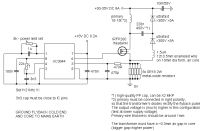
Driver and arc pics. The arc ignites at something like 12cm (5") at max. power.
Youtube vid:

(here I have three IRFP250's in parallel, but one 260 is perfectly fine, the heatsink is just a little warm after prolonged arcing fun
 )
)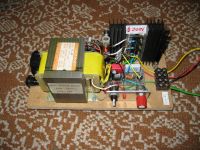

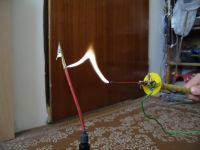
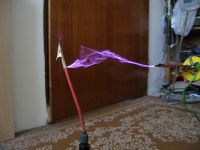
Spark after ignition
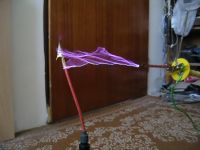
Corona before the arc strikes...

(sorry for the pic quality, they are snapshots from a video...
Re: Quasi-resonant flyback driver
Killa-X, Sat Oct 10 2009, 02:47PM
Looks like it works really nice kilovolt!
The only thing I was confused about, is long ago, i did a 555 + mosfet, and a reversed snubber. Somehow i was able to get arcs to start at 5", but they were veeery thin static sounding. Maybe it was my flyback? being a 45kv projection screen one... not sure...
Now is this better or similar to the ZVS driver? :D in performance :D
Killa-X, Sat Oct 10 2009, 02:47PM
Looks like it works really nice kilovolt!
The only thing I was confused about, is long ago, i did a 555 + mosfet, and a reversed snubber. Somehow i was able to get arcs to start at 5", but they were veeery thin static sounding. Maybe it was my flyback? being a 45kv projection screen one... not sure...
Now is this better or similar to the ZVS driver? :D in performance :D
Re: Quasi-resonant flyback driver
Dr. Dark Current, Sat Oct 10 2009, 03:07PM
you probably got thin arcs because the flyback pulse was very short, the resonant cap makes the flyback pulse more intense if that's the right word.
Not better or worse, its different. The ZVS just pushes a lot of power and the arc is hot as far as you draw it. Now this driver is theoretically a constant power source, so short arcs are hot, but as you draw the arc out, the current quickly drops (the purple "windy" arcs you can see in the photos).
Its better than ZVS in that it doesn't stress the diodes in a DC transformer as much, with the zvs they see almost double the reverse voltage for the same output voltage than with this driver.
Dr. Dark Current, Sat Oct 10 2009, 03:07PM
Killa-X wrote ...
Looks like it works really nice kilovolt!
The only thing I was confused about, is long ago, i did a 555 + mosfet, and a reversed snubber. Somehow i was able to get arcs to start at 5", but they were veeery thin static sounding. Maybe it was my flyback? being a 45kv projection screen one... not sure...
Now is this better or similar to the ZVS driver? :D in performance :D
Thanks,Looks like it works really nice kilovolt!
The only thing I was confused about, is long ago, i did a 555 + mosfet, and a reversed snubber. Somehow i was able to get arcs to start at 5", but they were veeery thin static sounding. Maybe it was my flyback? being a 45kv projection screen one... not sure...
Now is this better or similar to the ZVS driver? :D in performance :D
you probably got thin arcs because the flyback pulse was very short, the resonant cap makes the flyback pulse more intense if that's the right word.
Not better or worse, its different. The ZVS just pushes a lot of power and the arc is hot as far as you draw it. Now this driver is theoretically a constant power source, so short arcs are hot, but as you draw the arc out, the current quickly drops (the purple "windy" arcs you can see in the photos).
Its better than ZVS in that it doesn't stress the diodes in a DC transformer as much, with the zvs they see almost double the reverse voltage for the same output voltage than with this driver.
Print this page